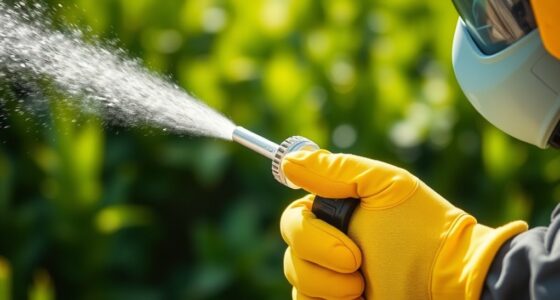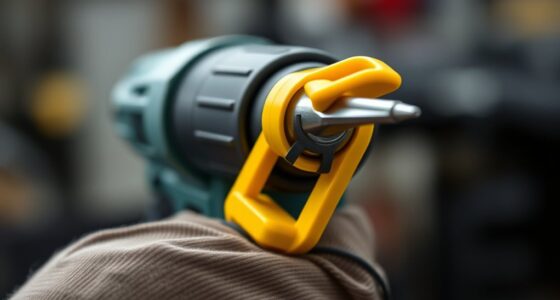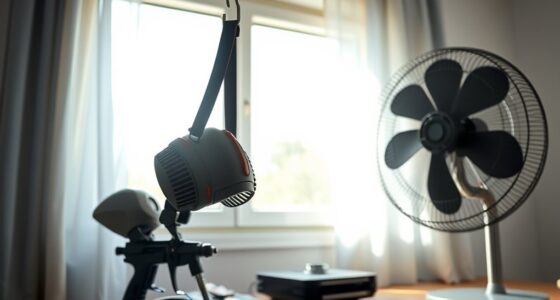To keep safe pressure levels with your airless sprayer, always check and adjust the pressure according to the nozzle and project needs. Regularly inspect and maintain equipment, ensuring hoses and fittings are secure and leak-free. Use gauges to monitor pressure continuously and respond quickly to any fluctuations or leaks. Proper PPE and safety procedures reduce risks, and understanding warning signs helps prevent accidents. Keep learning how to fine-tune and troubleshoot for safe, effective spraying.
Key Takeaways
- Regularly monitor pressure levels with gauges and adjust settings according to manufacturer guidelines.
- Inspect hoses, nozzles, and fittings for damage or leaks before each use.
- Test spray on scrap surfaces to ensure correct pressure and nozzle adjustments.
- Use appropriate PPE and follow safety procedures during operation and maintenance.
- Immediately relieve pressure and shut off the pump if irregular sounds, leaks, or pressure drops occur.
Understanding Airless Sprayer Pressure Settings
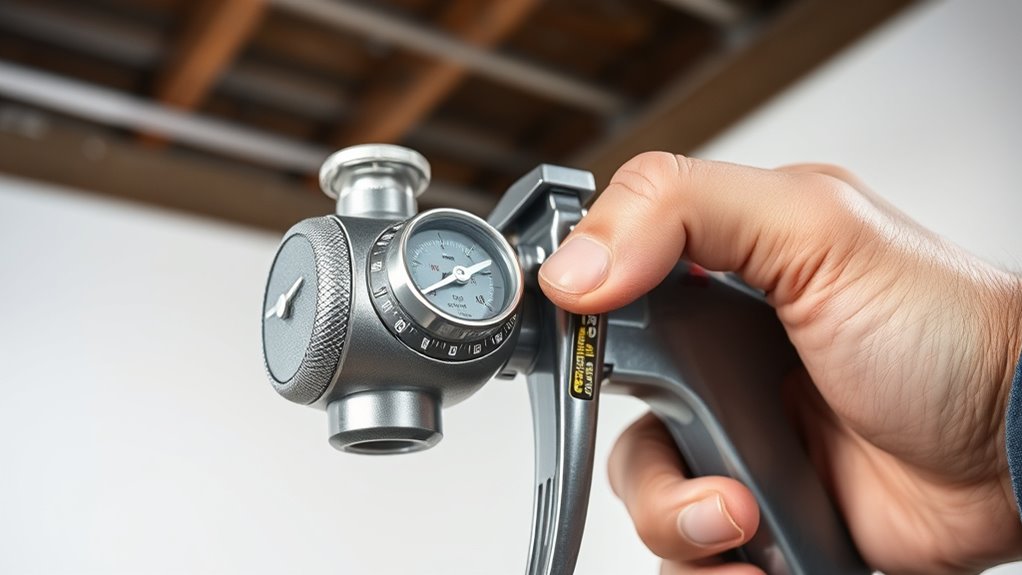
To guarantee safe and effective painting, it’s essential to understand how to set your airless sprayer’s pressure correctly. Proper pressure regulation ensures you control spray flow and avoid over-pressurizing the system, which can lead to accidents. Start by adjusting the pressure settings on your sprayer according to the manufacturer’s guidelines for your specific project. Pay close attention to nozzle adjustments, as they directly impact spray pattern and pressure distribution. A smaller nozzle requires less pressure, while a larger one might need higher pressure for optimal coverage. Always test your settings on a scrap surface before starting your main job. Correct pressure regulation combined with precise nozzle adjustments helps maintain safety and achieves a smooth, professional finish. Additionally, using the appropriate pressure settings for different materials and surfaces can prevent damage and ensure a consistent application.
Proper Equipment Inspection and Maintenance
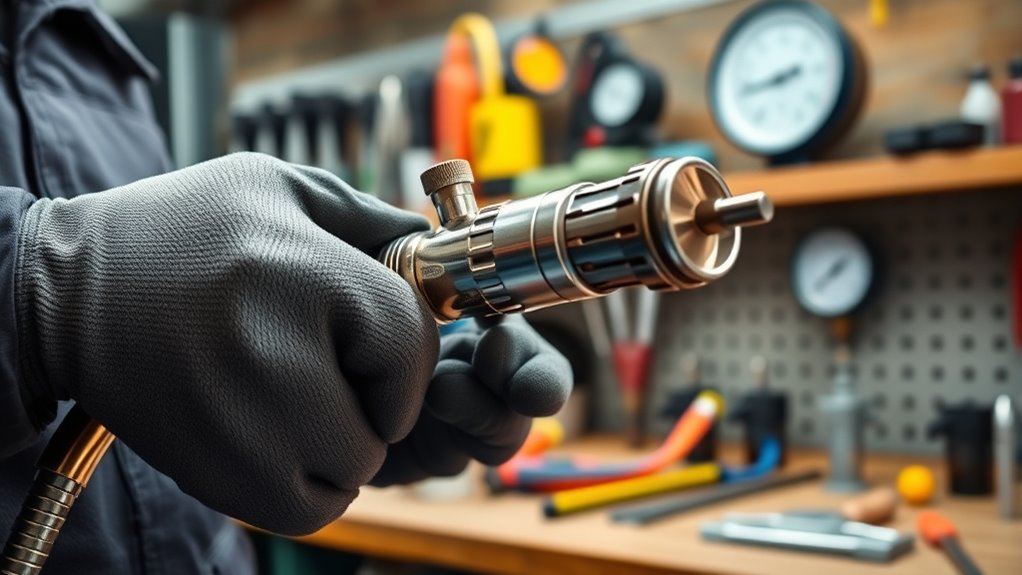
Regularly inspecting and maintaining your airless sprayer is essential for safe and efficient operation. Start by checking hose compatibility to ensure it’s rated for the pressure and material you’re spraying, preventing leaks or bursts. Examine hoses for cracks, wear, or damage, replacing them if necessary. Proper nozzle selection is equally important; use nozzles suited for your project and pressure levels to avoid over-pressurization or uneven spray patterns. Clean all components after each use to prevent clogging and buildup, which can compromise safety. Tighten fittings and inspect seals to prevent leaks. Keeping your equipment in top condition minimizes the risk of accidents caused by equipment failure and ensures consistent, safe application. Regular maintenance saves time and extends your sprayer’s lifespan. Incorporating preventive maintenance practices can further enhance safety and performance.
Correct Assembly and Setup Procedures
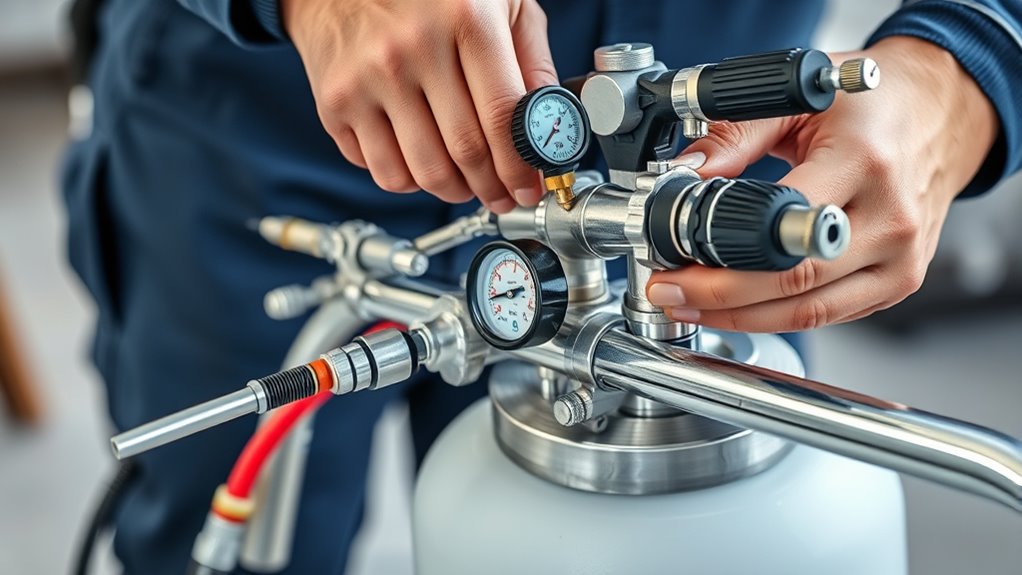
Proper assembly and setup of your airless sprayer guarantee safe operation and ideal performance. Start by ensuring the hose is properly connected, checking for hose durability to prevent leaks or bursts. Verify that the nozzle is compatible with your sprayer model to avoid pressure issues. Use the following table to guide your setup:
| Step | Action | Key Point |
|---|---|---|
| 1 | Attach hose securely | Check hose robustness for safety |
| 2 | Install compatible nozzle | Prevent pressure inconsistencies |
| 3 | Tighten fittings | Avoid leaks and pressure drops |
| 4 | Test run without paint | Ensure proper assembly before use |
Correct setup minimizes risks, extends equipment life, and ensures safe, efficient spraying. Additionally, always perform a test spray on a scrap surface to verify the spray pattern and pressure adjustments before starting your project.
Monitoring Pressure During Operation

During operation, you should regularly check the pressure to make certain it stays within safe limits. Use pressure gauges to get accurate readings and catch any fluctuations early. Avoid sudden pressure changes, as they can compromise safety and equipment integrity. Additionally, understanding security measures can help protect your equipment from cyber threats that may arise during digital monitoring.
Regular Pressure Checks
Monitoring pressure during operation is essential to guarantee safety and ideal performance. Regular pressure checks help you identify issues early, preventing accidents caused by sudden pressure surges or drops. Before starting, ensure your airless sprayer is properly calibrated; this guarantees consistent output and minimizes pressure fluctuation management challenges. Throughout the job, keep an eye on the pressure gauge, adjusting settings as needed to maintain a steady, safe pressure level. Frequent checks also help detect leaks or blockages that could cause unsafe pressure spikes. By staying vigilant, you avoid over-pressurizing the system, reducing the risk of equipment failure or accidents. Regional knowledge of local regulations and standards can further ensure compliance and safety during operation. Consistent pressure monitoring ultimately assures a safer working environment and optimal spray quality.
Use Pressure Gauges
Have you checked your pressure gauge recently? Using a pressure gauge is essential for effective pressure regulation during spraying. It provides real-time readings, helping you keep the pressure within safe limits. Regularly monitoring the gauge ensures you won’t accidentally over-pressurize the system, which can cause accidents or equipment damage. If the pressure approaches unsafe levels, rely on safety valves to release excess pressure safely. These valves act as a critical safety feature, preventing dangerous pressure buildup. Make it a habit to glance at the gauge frequently throughout your operation, adjusting settings as needed. Consistent use of pressure gauges combined with safety valves keeps your work safe and your equipment functioning smoothly. Always prioritize accurate monitoring to avoid unexpected pressure surges. Proper pressure regulation is vital to maintaining equipment longevity and safety during operation.
Avoid Sudden Pressure Changes
To prevent accidents or equipment damage, you need to keep a close eye on pressure changes as you work. Sudden pressure fluctuation can cause spraying inconsistencies or even equipment failure. Regularly monitor your pressure gauge, especially during start-up and when adjusting settings. Confirm your equipment calibration is accurate; miscalibrated tools can lead to unexpected pressure drops or spikes. Avoid rapid throttle adjustments or abrupt connections, which can trigger sudden pressure shifts. Consistent, gradual changes help maintain stable pressure levels, reducing the risk of accidents. Staying vigilant about pressure fluctuation and verifying calibration keeps your operation safe and efficient, preventing damage and ensuring a smooth spraying process. Additionally, understanding pressure regulation techniques can help you maintain optimal operating conditions and avoid dangerous pressure surges.
Safe Handling and Personal Protective Equipment

When handling pressurized systems, you need to select the right personal protective equipment to stay safe. Always follow proper handling practices to prevent accidents and injuries. By using the correct PPE and handling techniques, you safeguard yourself and ensure safe operation. Additionally, understanding safety guidelines specific to airless sprayers can further reduce the risk of mishaps.
Proper PPE Selection
How can you guarantee your safety when handling pressurized systems? Proper PPE selection is vital for airless sprayer safety. The right personal protective equipment shields you from harmful overspray, chemical exposure, and high-pressure spray risks. Always wear a respirator or mask to prevent inhaling fumes or particles. Safety goggles or a face shield protect your eyes from splashes. Gloves are essential to avoid skin contact with chemicals, and long sleeves plus coveralls minimize exposed skin. Remember, PPE importance can’t be overstated—each piece acts as your first line of defense. Choosing appropriate PPE based on the materials and pressure levels ensures safer operation and reduces accident risks. Prioritize your safety by selecting gear that fits well and meets safety standards every time you work with an airless sprayer. Incorporating automation in safety checks can further enhance adherence to protective measures.
Safe Handling Practices
Handling pressurized systems safely requires careful attention to both your actions and protective gear. Always verify your airless sprayer is properly calibrated to avoid over-pressurization. Before starting, check that pressure relief valves are functioning correctly—they prevent dangerous pressure buildup. When operating, keep your hands and face protected with appropriate PPE, including gloves and goggles. Use the following table to guide your safe handling:
| Action | Purpose |
|---|---|
| Regular airless sprayer calibration | Ensures consistent pressure and performance |
| Testing pressure relief valves | Prevents accidental over-pressurization |
| Wearing PPE during operation | Protects against sprays and accidental releases |
Additionally, proper maintenance practices are essential to ensure your sprayer operates safely and efficiently over time.
Recognizing and Responding to Pressure-Related Issues

Are you able to spot the early signs that pressure levels are becoming unsafe? If you notice irregular sounds, leaks, or sudden pressure drops, it’s time to act. Immediate pressure relief is essential to prevent accidents. Know your equipment’s emergency procedures, such as shutting off the pump and releasing pressure safely. Don’t ignore warning signs like fluctuating spray patterns or unexpected vibrations—these indicate pressure issues. Always stay alert and prepared to respond quickly. If you feel uncomfortable or suspect a pressure problem, stop using the sprayer and follow your safety protocol. Proper maintenance and troubleshooting can help prevent pressure-related issues before they become hazardous. Prompt action minimizes risks and helps maintain safe operation. Recognizing these signs early can prevent equipment failure or injuries, making safety your top priority.
Best Practices for Safe Cleanup and Storage

To guarantee safety after use, it’s essential to follow proper cleanup and storage procedures. Always wear protective gear when handling hazardous chemicals leftover from the sprayer. Proper disposal of paint, solvents, and other residues minimizes environmental impact and prevents contamination. Rinse the sprayer thoroughly with water or an appropriate solvent, following manufacturer guidelines. Store chemicals in clearly labeled, sealed containers away from heat and direct sunlight to prevent leaks or reactions. Keep the sprayer in a secure, dry location to avoid accidental damage or misuse. Regularly inspect stored chemicals for leaks or deterioration. Additionally, ensure proper air purifier maintenance to keep the environment safe and free from airborne contaminants. By adhering to these best practices, you reduce health risks, prevent environmental harm, and ensure your equipment remains safe and effective for future use.
Frequently Asked Questions
How Often Should I Replace Parts on My Airless Sprayer?
You should follow your sprayer’s maintenance schedule and replacement intervals to keep it working efficiently. Typically, replace spray tips every 6 to 12 months, depending on usage. Hoses and seals might need more frequent checks, especially if you notice leaks or reduced pressure. Regular maintenance prevents unexpected breakdowns and ensures safety. Keep track of your parts’ condition and replace them promptly to maintain peak performance and avoid accidents.
Can I Use the Sprayer at Lower Pressure for Delicate Surfaces?
You can use your airless sprayer at lower pressure for delicate surface preparation, which helps prevent damage. Adjust the sprayer to the ideal pressure settings for the specific surface you’re working on, ensuring a smooth finish without overspraying or causing splatters. Lowering the pressure allows you to control the spray better, making it suitable for fragile materials or detailed work, ultimately giving you a more professional and safe result.
What Are the Signs of a Failing Pressure Regulator?
You’ll notice signs of a failing pressure regulator if you see pressure fluctuation during spraying or inconsistent spray patterns. Additionally, regulator leakage is a clear indicator; if you spot air or fluid leaking around the regulator, it’s time to replace it. These issues compromise your sprayer’s performance and can lead to unsafe situations, so regularly check your regulator and address any signs of failure promptly to maintain safe, effective operation.
Is It Safe to Leave the Sprayer Pressurized Overnight?
Leaving the sprayer pressurized overnight isn’t safe because of potential safety concerns. Overnight pressure can cause leaks or accidental releases if the equipment isn’t designed for long-term pressure retention. Always depressurize your airless sprayer after use, especially if you won’t be working with it for a while. This practice prevents accidental leaks and reduces the risk of injuries or damage, ensuring safe handling and operation.
How Do Temperature Changes Affect Sprayer Pressure and Safety?
Did you know that temperature fluctuations can cause up to 30% pressure changes in airless sprayers? When temperatures rise or fall, pressure stability gets compromised, increasing the risk of accidents. You need to monitor how outdoor conditions affect your equipment, especially during extreme weather. By understanding these effects, you can prevent pressure buildup or loss, ensuring your safety and the sprayer’s proper functioning.
Conclusion
By following these safety tips, you’ll keep accidents at bay and guarantee smooth spraying sessions. Always stay attentive and don’t cut corners—remember, a stitch in time saves nine. Regularly check your equipment, monitor pressure closely, and wear proper protection. When you stay vigilant, you’ll avoid mishaps and keep your work safe and efficient. Keep safety at the forefront, and you’ll be able to spray with confidence every time.




